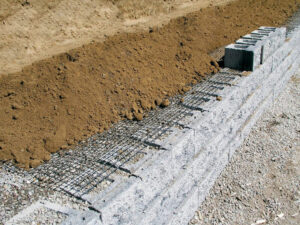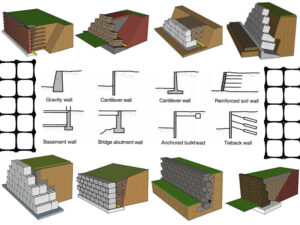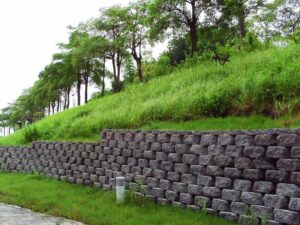Geotextile, Geocomposite Drainage Net Used For Drainage, Permeable, Filter
Drainage, permeable, and filter are critical in engineering projects. They direct excess moisture away from soil or structures, prevent water accumulation, reduce pressure or erosion caused by water buildup, and minimize potential damage. As water is drained, soil particles or debris are blocked from entering the drainage system, ensuring its long-term effectiveness and preventing blockages.
A proper geocomposite drainage system can prevent structural instability and soil sliding. Permeability helps alleviate issues related to surface runoff and soil saturation, while filtration plays a key role in protecting drainage facilities and maintaining soil structure stability.
To achieve these functions, two geosynthetic products are commonly used in engineering: geotextiles and geocomposite drainage nets.
Geotextiles offer good permeability and filtration performance, making them ideal for use in filtration and drainage layers. They allow water to pass through freely while preventing soil particles from entering the drainage system, thus protecting the stability of structures. Non-woven geotextiles are the best product for achieving both filtration and drainage.
Geocomposite drainage nets are made by combining geonets with materials like geotextiles, providing drainage, filtration, and protection in one product. They not only effectively discharge excess water but also offer excellent filtration and reinforcement.
Therefore, geotextiles or geocomposite drainage mats are the best synthetic materials for achieving drainage, permeability, and filtration functions.
Geotextile, Geocomposite Drainage Net Introduction
Geotextiles and geocomposite drainage sheets are the best materials used in engineering for achieving functions like drainage, permeable, and filter. Each product has distinct features, functions, and applications. Among them, non-woven geotextile filter fabric is widely used, and it comes in different weights, such as 4 oz and 8 oz.
For more detailed information, please click the button below to learn more.
Woven Geotextile
Non-Woven Geotextile
Geocomposite Drainage Net




Geotextile Used For Drainage, Permeable, Filter
Geotextiles membrane have excellent drainage and permeability properties.
Thanks to their strong permeability, they allow water to pass through, directing and discharging excess moisture while preventing soil particles from being washed away. This reduces water pressure in the soil and prevents structural instability caused by soil saturation.
The drainage and permeability functions of geotextiles fabric play a key role in preventing water accumulation and maintaining the soil’s natural drainage capacity. Especially in projects such as slope protection, basement drainage systems, dams, and tunnels, the drainage and permeability of geo facbric are crucial for preventing landslides and erosion.
By ensuring that these structures remain dry and stable over long periods, geotextiles help protect the long-term stability of infrastructure.
Geotextiles also have excellent filter drain performance, with non-woven geotextiles fabric offering even stronger filter drain capabilities.
Through their fiber structure, geo cloth filter soil particles and debris, preventing them from entering drainage systems and thus preventing blockages in drainage pipes and systems.
This is crucial for ensuring the long-term operation of drainage systems. For instance, in filter layer applications in dams, impermeable walls, and slope projects, geotextiles ensure soil stability and protect drainage systems from being affected by impurities.
Geocomposite Drainage Net Used For Drainage
Geocomposite drainage nets typically consist of a three-layer structure with a core geonet layer and geotextiles (either non-woven or woven) on both sides.
The core geonet layer is usually made of high-density polyethylene (HDPE) or similar materials, offering high compressive strength and excellent drainage capacity.
Through this intricate three-dimensional structure, geocomposite drainage mats easily achieve dual functions of drainage and filtration.
They efficiently discharge excess moisture from soil or structures, reduce water pressure, and maintain the smooth operation of drainage systems.
In this design, the middle geonet provides channels for water flow, while the geotextiles on both sides act as filters and protective layers, preventing soil particles from entering the drainage channels.
Especially under high-pressure conditions, their compressive strength ensures that the drainage channels do not become compressed or blocked.
Geocomposite drainage sheets serve as an integrated drainage system solution. They are particularly useful in projects such as tunnels and underground works, slopes and retaining walls, landfills, and rockfill dams.
These geocomposite drainage system simplify construction processes, reduce material usage and construction time, and, compared to traditional drainage materials, offer significant advantages in terms of construction efficiency and economic benefits.
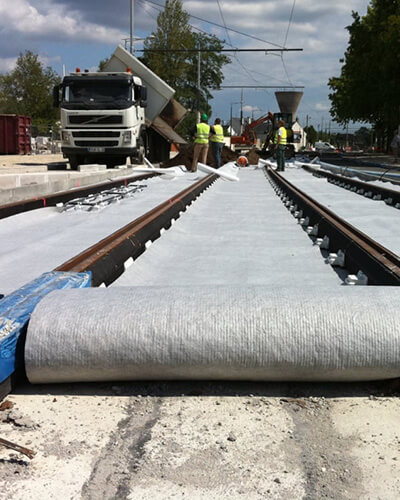
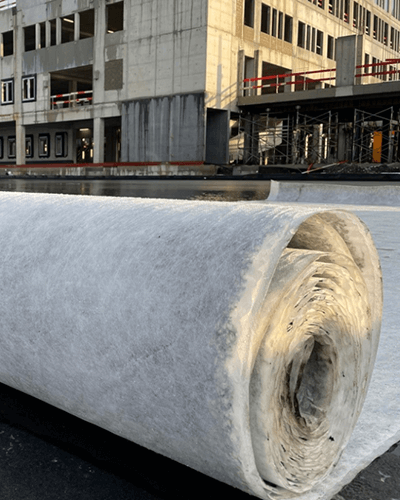
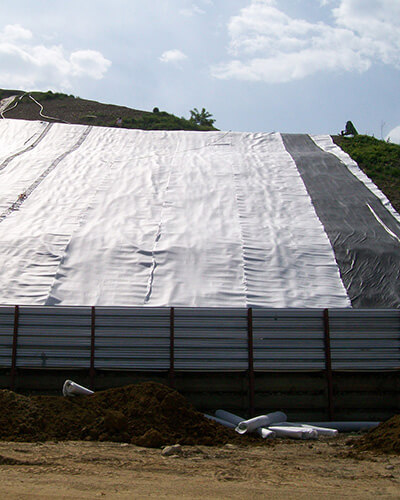
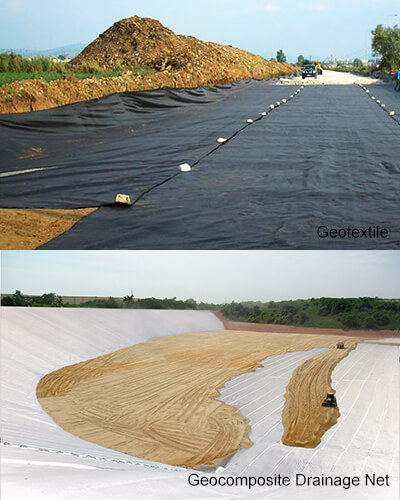
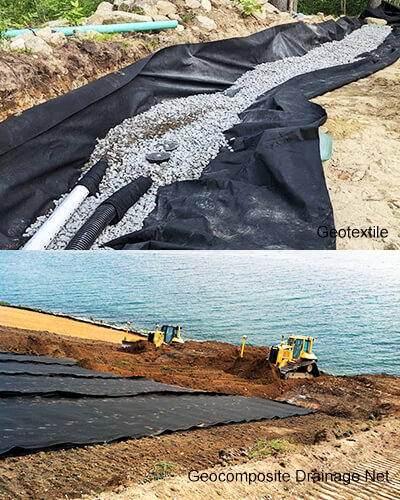
Should We Choose Geotextile or Geocomposite Drainage Net to Realize Drainage, Permeable, and Filter Functions In The Project?
Choosing between geotextiles and geocomposite drainage nets for achieving drainage, permeability, and filtration functions depends on analyzing the material properties and project requirements. Geotextiles perform well in drainage, permeability, and filtration, while geocomposite drainage mats offer superior drainage capabilities.
In projects with gentle terrain and low water pressure, such as light-load roadbeds, landscaping, and soil protection, geotextiles fabric are used. These types of projects have lower requirements for drainage, filtration, and permeability, and the engineering is relatively simple.
In projects with strict drainage system requirements, such as tunnels, underground structures, large rockfill dams, and landfills, geocomposite drainage sheets are used. These projects require efficient drainage, rapid permeability, and multi-layer filtration to ensure structural stability.
Therefore, you can make a simple choice based on the following points:
Drainage Needs
Geotextiles, especially non-woven geotextiles filter fabric, offer good permeability and filtration performance, making them suitable for projects that require guiding water flow out. In situations where high-efficiency drainage is not needed, such as landscaping projects, light-load road foundations, and simple slope protection, geo fabric can meet drainage needs and are more economical.
Geocomposite drainage nets, with their three-dimensional structure, provide excellent drainage channels. They can efficiently discharge large volumes of water while maintaining channel flow and structural stability under high-load environments. In projects like tunnels, underground structures, rockfill dams, and landfills, where large amounts of water need to be managed or where greater pressure is involved, geocomposite drainage layer are more effective in preventing structural damage caused by water accumulation.
Permeable Requirements
Geotextiles ensure that water passes through quickly without accumulating in the soil due to their excellent permeability. They perform well in controlling the flow rate of water, making them suitable for projects that require slow drainage and gradual infiltration. For flat terrain that needs slow drainage, such as green spaces and slope protection, geo cloth are an ideal choice.
Geocomposite drainage nets combine the dual functions of permeability and rapid drainage, making them especially suitable for environments that require quick and effective drainage, such as underground drainage systems and drainage around tunnels. In projects where rapid removal of soil moisture is needed to prevent water pressure buildup, the drainage of geocomposite sheets is more appropriate.
Filtration Requirements
Geotextiles, especially non-woven geofabric, have tiny pores that effectively block soil particles and fine sediments, preventing them from entering the drainage system while allowing water to pass through. They serve as the primary solution for filtration functions. In projects that require fine filtration and prevention of particle loss, such as protective layers around drainage pipes and soil remediation projects, geotextile membranes perform exceptionally well.
Geocomposite drainage nets are typically attached to geotextiles on both sides, allowing them to not only drain water but also provide effective filtration protection to prevent clogging of drainage channels. This combines the filtration function of geotextiles with the drainage capability of geonets, creating a comprehensive solution. They are an excellent choice for projects like underground drainage systems, rock-fill dams, and landfills that require extensive drainage and filtration.
Project Applicability
Geotextiles are suitable for projects with limited budgets, offering good permeability and filtration capabilities to meet the drainage and protection needs of most conventional civil engineering applications. In simple, stable environments, the installation and maintenance of geo fabric are straightforward, making them suitable for light to medium-load projects.
Geocomposite drainage mats are suitable for complex, heavy-load, and high-pressure environments, providing excellent performance in drainage, permeability, and filtration. They are particularly well-suited for projects that require long-lasting and efficient drainage, such as tunnels, underground structures, and large infrastructure projects.
Cost-Effectiveness
Geotextiles are inexpensive, with lower material and installation costs, making them suitable for conventional projects and those with tight budgets. Their simple installation makes them ideal for small or straightforward projects, especially in complex or irregular terrains.
Geocomposite drainage sheets are more expensive, but their high drainage efficiency and long service life can reduce maintenance and replacement costs over time, making them suitable for large-scale or complex projects.
Recent Projects
Discover our recent client projects and explore the range of tailored, personalized support we provide. Share your requirements and receive the ideal solution.
Recent Company News
Explore our newest releases, stay informed with industry updates on geosynthetics & geocomposite, and delve into technical insights about geotechnical products. For any queries, reach out to us for customized assistance.
Frequently Asked Questions
You need to analyze based on the specific project, and here’s a simple decision-making method:
Use geotextiles membrane for projects in flat terrains and with low water pressure, such as light-load subgrades, landscaping projects, and soil protection. These types of projects do not have high requirements for drainage, filtration, or permeability, and are relatively straightforward.
Use geocomposite drainage system for projects like tunnels, underground structures, large rock fill dams, and landfills, which have strict requirements for drainage systems. These projects require efficient drainage, rapid permeability, and multiple filtration functions to ensure structural stability.
In terms of cost, geotextiles cloth are generally less expensive, while geocomposite drainage sheets have a higher price. Therefore, geotextiles have a significant cost advantage.
However, for large geotechnical engineering projects, it is recommended to choose the more expensive geocomposite drainage nets to ensure the quality of the project.
Both geo textiles and geocomposite drainage nets are very easy to install during construction.
For specific installation methods, you can check the following link:
In terms of durability, geocomposite drainage mats perform better. However, geotextiles fabric are also very durable.
Both geofabric and geocomposite sheets are considered environmentally friendly materials, and their use does not negatively impact the surrounding environment. On the contrary, they help protect the ecological balance of the area.

